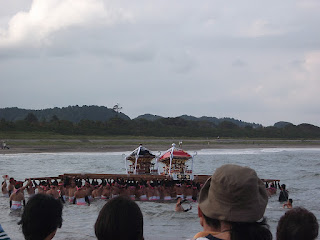Our first stop was the Kasori Shell Mounds Museum, whose name I am sure to remember in both Japanese and English because it came up in my first interpreting job but all I could say was 'shell mounds' instead of its proper name. The shell mounds there are the biggest ones in Japan, and I think some of the biggest in the world, too. They are split into the north and south shell mounds, and actually the area where they are is open to the public all the time (only the museum has hours), which I think is pretty cool. When we got there, we got to go on a guided tour led by a volunteer, who explained a lot about the shell mounds for us.
I was a little bit surprised because the majority of the shell mounds are actually left exactly as they are without any excavation, which means that when you look at it you mostly just see the grass and plants that have grown up on top of them, with the slight elevation being the only indication that the mounds are there. Apparently they have decided not to excavate any further than they did in the 1950s, in the interest of preserving them. There are several places where you can see where they did excavate, though! They're basically cross-sections of the mounds behind glass, and it's really interesting to see just how many shells are piled up there. In the southern mounds, you can also see animal and fish bones mixed in, as well as ashes from (cooking?) fires.
After looking at the mounds from both the outside and the inside, we went into the museum, which I found pretty interesting. There was a lot of information about shell mounds in Japan and the people who lived around the Kasori Shell Mounds (and created them, I suppose), including things like their jewelry, pottery, living spaces, etc. As our tour guide was explaining things to us as we walked through, I was too busy trying to pay attention to what he was mentioning at the time to really take a full look at everything on display, so I'll have to go back some time and take my time! Admission is only 60 yen for adults, so I think it's definitely worth it.
 |
| Shells and some ashes in the mounds |
Our next stop was the Shimoda Agricultural Fureai Center, which was established to give citizens of the city a chance to get closer to the local agriculture. There's a little market where you can buy local produce, as well as a restaurant that uses all local produce in its dishes. We learned about a program they did with elementary school students, where the kids went on field trips to farms in the area and then created a map that included the places they went and things they saw. It was a really impressively well-made map, considering it was done by 10 sixth-graders, and I thought that having that kind of program was a really good idea.
We had lunch in the restaurant there, which was really tasty! It was buffet-style and there were a lot of different options, so naturally I had to try them all. It seemed like it was the kind of food that you would normally eat in a Japanese home (as opposed to a restaurant), which was a nice change from everywhere else that I've been eating lately.
Our final stop was the Chiba City Folk Museum, which is in a building that looks like a traditional Japanese castle. Despite what a lot of people may think, though, it isn't a real castle that people lived in (like all of the other castles you can visit in cities like Nagoya, Osaka, everywhere) - apparently it was constructed in 1967 on the site of the original Chiba Castle (not sure what happened to it) to be a symbol of the city (or something). I was pretty amused that this wasn't a real castle (though it does look impressive), just like I was amused by all the various works featuring Chibanosuke Tsunetane, the leader of the Chiba clan and apparently a pretty big deal, that all looked different because nobody knows what he actually looked like. The museum is all about the history of Chiba City, and their current special exhibit is of the clothes that people wore when delivering things from or working at certain shops, which were kind of like their brands and so unique to every place (from what I understood of our guide's explanation, at least). My favorite was one for a sushi place, where the logo looks like a shrimp but is actually made up of the characters for 'sushi'.
As with all castles in Japan (or at least all the ones I've been to), we were able to go up to the top and go outside on a little veranda that went all around the castle, to see a view of all of Chiba City. Unfortunately it was a rainy day and not very clear, but it was still cool to look around and try to find the places that I knew (which is admittedly not many, haha).
Apparently the folk museum also has a monthly event when you can try on traditional clothes and armor, which sounds like a lot of fun. You do have to apply for it, but really it's just submitting your name/address/phone number to their email (kyodo.EDL@city.chiba.lg.jp) so that they can do a lottery in case there are more people who show up than they have outfits for. Admission is only 60 yen here too, so I might want to come back and try on some armor sometime!
All in all, I had a great day going from place to place - it was definitely more exciting than sitting at my desk translating all day! :)





